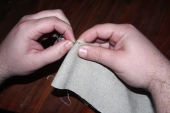Thank you Susan, that was very informative and gave me a good basic understanding of the scaffold and multiple layering principals. I will still have to determine just how much pruning I want to do but even the minimal will require selection. I am pretty sure it was pruned at the nursery to eliminate the lower growth. I have read how they do that with most their trees. I don't know if it has a health component or just for most people's aesthetic but I knew that getting anything else was going to be very difficult in my area. My hope is to get these trees growing and the guilds in place and then add seeds & seedlings for the second generation which can be established more to permaculture principals without grafts, deep tap roots and low branches. But first things first.
I thought it interesting that he suggested not letting it fruit in the first year (or two?) to build a stronger form. That would suggest I pinch off much of the other tree's sets as well. I was going to lighten the load anyway but now I'll be more severe. I had planned on still watering regularly though perhaps a bit less intensely to force root growth (which may depend on the actual weather) and less fruit will mean less stress. It is a shame as so many years get no fruit that in a year with the perfect weather I'm going to restrict it.

Thanks Bryant, as that is exactly the advice I was hoping for. I feared just bending it over and leaving that big curve. I hadn't thought of using several lines and adjusting them over time. I have done that with house plants that wanted to stray out of their pots so I can see it would work here as well.
John, I see what you are saying, and after watching this video I better understand the options, so as I am worried about the weight of this side anyway that may very well dictate my selection. Thanks for pointing that out. I presume I should wait for the dormant season (late fall or winter...) to make that cut anyway? It sounds like there may be a decision as to which of the two leads will be taken off as the "lower" one might be favored to stay? Or would that close angle still be a problematic structure even without the other side?
Joseph, that was my first inclination too. I'm glad to hear someone else likes "interesting" tree shapes. I believe I will try to err on the side of balance this year, however, just to ensure the whole thing doesn't fall over before it can grow decent roots. I doubt it will ever be very symmetrical with this start and that is fine with me as it will add interest to the future stroll though the garden. I anticipate my windy conditions may do some other unplanned pruning in the future as well.












